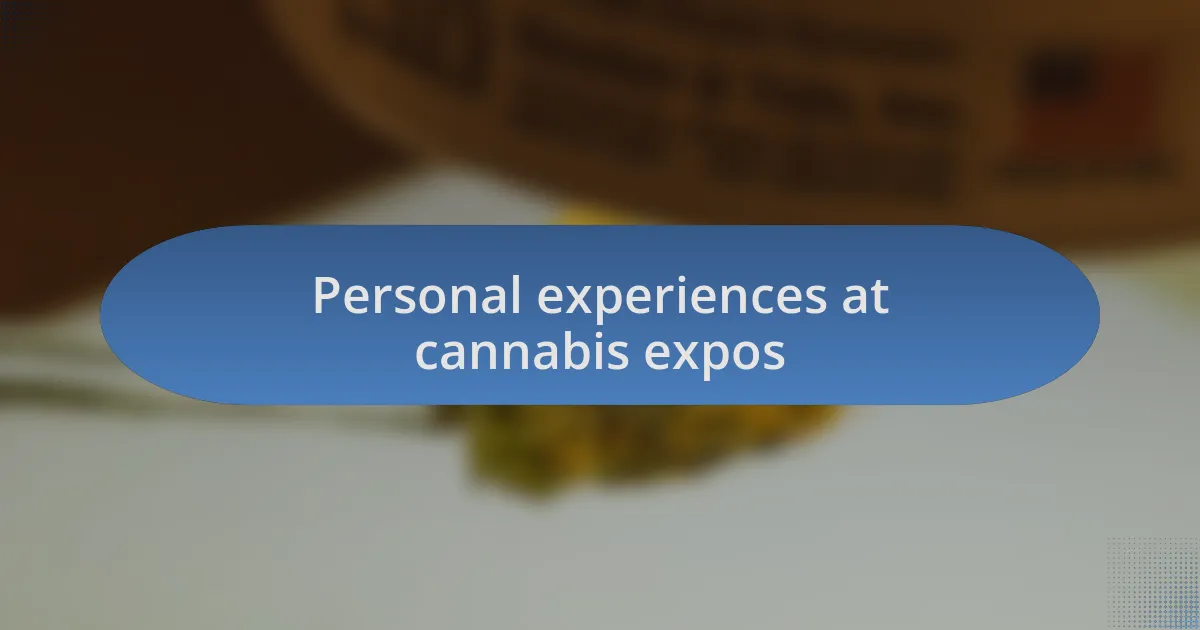Key takeaways:
- Understanding cannabis research involves exploring the endocannabinoid system and the different therapeutic effects of cannabinoids.
- Cannabis expos facilitate knowledge sharing, foster community, and bridge the gap between scientists and consumers.
- Effective cannabis research requires a structured approach, collaboration, and staying updated with the latest developments in the field.
- Evaluating the impact of research findings is enhanced by combining scientific data with personal testimonials and narratives from users.

Understanding cannabis research
When I first delved into cannabis research, I was surprised by its complexity. The almost endless array of compounds, such as THC and CBD, fascinated me. Have you ever wondered how these compounds interact with our bodies? Understanding the endocannabinoid system, which regulates various bodily functions, is essential to grasping how cannabis works.
One of my most eye-opening moments was attending a seminar where researchers shared their findings on cannabis’ potential benefits for mental health. I never expected to hear about the positive effects it could have on anxiety and depression. This personal connection to the topic made me realize just how crucial it is to conduct well-rounded research that considers diverse perspectives.
As I engaged more with the scientific community, I learned that rigorous studies are vital for cannabis research. Many people are eager to discover what works for them, but without solid evidence, it’s easy to get lost in a sea of anecdotal claims. Isn’t it reassuring to know that ongoing research aims to provide clarity and direction in this evolving field?

Importance of cannabis expos
Attending cannabis expos has been a game-changer for my understanding of the industry. I remember walking through the booths, feeling the energy and enthusiasm of the attendees. Have you ever found yourself in a place where the passion for a topic is almost palpable? These gatherings create a unique environment where knowledge-sharing happens organically, allowing everyone to learn from experts and fellow enthusiasts alike.
These expos are not just about showcasing products; they are vital platforms for collaboration and innovation. I’ve witnessed firsthand how connections formed at these events can lead to groundbreaking studies and initiatives. Isn’t it exciting to think about how one conversation sparked by a shared interest can evolve into significant advancements in cannabis research?
Moreover, expos play a crucial role in bridging the gap between the scientific community and consumers. I recall a panel discussion where researchers interacted directly with the audience, answering questions that mattered to real people. This exchange fosters transparency and trust, allowing attendees to leave with not just products, but valuable information that can impact their choices and wellness journey. It truly emphasizes the importance of community in understanding cannabis.

Key topics in cannabis research
Key topics in cannabis research are diverse and essential for understanding the plant’s potential. One area that has piqued my interest is the way cannabinoids interact with our endocannabinoid system. I often think back to a research presentation I attended at an expo, where they discussed how different cannabinoids can produce varying therapeutic effects. Isn’t it fascinating how something as simple as a chemical compound can have such profound implications for our health and well-being?
Another critical topic is the ongoing exploration of cannabis strains and their specific benefits. I remember trying different strains for various purposes, and noticing how each one brought a unique experience. It makes me wonder: why haven’t we fully tapped into the genetic diversity of cannabis? Understanding the nuances in strain profiles could lead to more targeted therapies and enhanced wellness options.
Moreover, the legal landscape surrounding cannabis research is ever-evolving. I recall attending a legal panel where experts debated the shifting regulations and their impact on research opportunities. It made me realize how important it is for researchers to navigate these laws effectively. How can we ensure that valuable studies aren’t stifled by bureaucratic hurdles? This discussion opened my eyes to the interplay between policy, science, and the future of cannabis as a legitimate field of study.

How to conduct effective research
Conducting effective research in cannabis requires a structured approach. When I’m diving into a new study, I often start with a clear set of questions that guide my inquiry. For instance, what specific outcomes am I looking to achieve? This acts like a compass, keeping me focused on relevant information.
I’ve also found that collaborating with others enhances my research experience. I remember a small group discussion where we pooled our findings on cannabinoid effects. The varied perspectives sparked new ideas and deepened my understanding. Isn’t it remarkable how sharing knowledge can lead to breakthroughs that one might not achieve alone?
Finally, staying updated with the latest developments in cannabis science is crucial. I often subscribe to reputable journals and attend industry webinars to keep my knowledge current. It’s an exhilarating feeling to connect the dots between emerging research and real-world applications. How do you stay informed about changes in this ever-evolving field? Finding the right resources can be a game-changer in your research journey.

Personal experiences at cannabis expos
Walking into my first cannabis expo felt like stepping into a vibrant world of possibilities. I remember being overwhelmed by the sheer variety of products and ideas on display. One booth, in particular, showcased innovative extraction methods that I hadn’t encountered before. Engaging with the enthusiasts there sparked a deep curiosity within me. Have you ever felt that rush of excitement when you discover something new and intriguing?
During another expo, I had the opportunity to chat with a grower who shared their personal experience with cultivating specific strains. Hearing about their challenges and successes made the science behind cannabis cultivation feel more tangible. It’s one thing to read about it, but hearing these stories from passionate individuals adds layers of understanding. Don’t you think personal stories can often resonate deeper than mere statistics?
What struck me most at these events was the sense of community among attendees. I found comfort in exchanging ideas with fellow researchers, consumers, and industry professionals. Each conversation broadened my perspective, reminding me that we are all on a shared journey of discovery in this field. Is there a better feeling than connecting with people who share your passion? These moments enrich the experience and often inspire new research avenues I hadn’t considered before.

Evaluating the impact of findings
Evaluating the impact of findings in cannabis research is crucial. After attending numerous expos, I’ve learned that data often tells a richer story when placed in context. For instance, attending a seminar on cannabinoid effects opened my eyes to studies that, while filled with numbers, truly gain depth when coupled with personal narratives from users. Have you ever noticed how a single story can illuminate a statistic?
As I reflected on the diverse presentations, I realized that the combination of scientific findings and anecdotal evidence creates a more vivid understanding of cannabis’s impact. I remember a speaker who shared how specific strains alleviated their chronic pain, which made the research resonate on a personal level. This blend of data with real-world experiences not only validates findings but enhances their credibility. Isn’t it fascinating how personal testimony can bridge the gap between research and reality?
Ultimately, evaluating the impact of findings means recognizing the interplay between science and experience. When I sift through the research, I make a conscious effort to look for these connections. For instance, one study I came across highlighted how terpenes influenced mood, but it was the stories from users that truly brought the data to life. How often do we find ourselves looking for that human element in research?